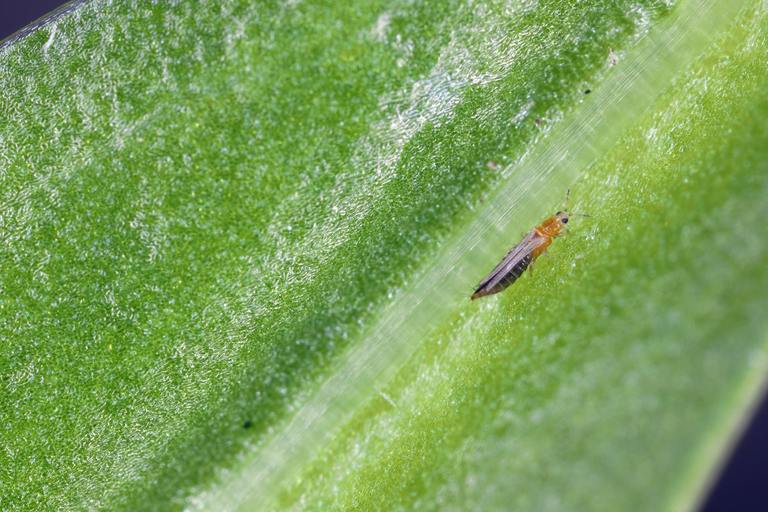Understanding Thrips: Tiny Pests with a Big Impact
Published: August 21, 2025

Introduction
Thrips are some of the smallest but most destructive insects gardeners, farmers, and homeowners can encounter. Despite their size, thrips can cause significant damage to plants, flowers, and crops, leading to economic losses and frustration for those trying to maintain healthy landscapes. As pest control professionals continue to explore effective solutions, it’s crucial to understand these pests, how they behave, and the best strategies to manage them.
In this blog, we’ll dive deep into what they are, how they impact plants, why they’re becoming an even bigger concern in 2025, and the latest prevention and control techniques. Whether you’re a greenhouse grower, a backyard gardener, or a Florida homeowner battling these invaders, knowing how to deal with them is essential.

What Are They?
Thrips are tiny insects, usually less than 1/20 of an inch long, that feed on plants by puncturing their cells and sucking out the contents. This feeding behavior leads to silvery streaks, stippling, or distorted growth on leaves and flowers. Their small size and rapid reproductive cycle make them especially difficult to manage once an infestation starts.
There are more than 6,000 known species of thrips worldwide, and while not all are harmful, many species pose a direct threat to agriculture and horticulture. They not only weaken plants but can also spread viruses, compounding the damage they cause.
The Growing Threat of Thrips in 2025
Recent research shows that invasive thrip species are spreading more rapidly across different regions, creating new challenges for pest management. Scientists have issued warnings about species that are adapting to new climates and food sources, making them harder to control. Greenhouse growers have reported significant issues with invasive thrips species, putting added pressure on the agricultural industry.
In Florida, they are an ongoing concern due to the warm, humid climate that allows them to thrive year-round. For example, the chilli thrips is one species that has become a serious pest in landscapes and ornamental gardens. Chilli thrips feed on hundreds of different plant species, making them highly destructive and difficult to eradicate once established.

Identifying Damage
Spotting them can be tricky because of their size, but the signs of their feeding are often more visible than the insects themselves. Common symptoms of thrips damage include:
- Silvery or bronze streaks on leaves
- Deformed or curled leaves
- Buds failing to open or developing abnormally
- Black specks of excrement on plant surfaces
- Flowers that appear dull, streaked, or discolored
Because these signs can resemble nutrient deficiencies or other plant problems, thrips infestations are sometimes misdiagnosed, leading to delays in effective treatment.
Thrips and the Spread of Plant Viruses
One of the most concerning aspects of their infestations is their ability to transmit plant viruses. For example, the tomato spotted wilt virus (TSWV) is spread primarily by thrips and can devastate tomato, pepper, and peanut crops. Even small populations of thrips can introduce such viruses into an area, causing widespread losses.
This virus-transmission ability is what makes a thrip more dangerous than just their direct feeding damage. Farmers and gardeners must monitor plants regularly to catch infestations early and prevent virus spread.
Florida Landscapes
Florida homeowners and landscapers often encounter them as recurring pests throughout the year. The University of Florida IFAS Gardening Solutions explains that thrips can affect a wide variety of ornamental and fruiting plants. Roses, peppers, strawberries, and many flowering ornamentals are particularly susceptible.
Chilli thrips, in particular, have become a major problem in Florida landscapes. Unlike many other species that focus on leaves and flowers, chilli thrips attack both young foliage and tender shoots, leading to stunted growth and plant decline. Their wide host range makes them one of the most difficult species to manage.
Prevention and Monitoring
Since they are so small and reproduce quickly, prevention and early detection are key to managing infestations. Here are a few best practices:
- Regular Monitoring: Inspect plants weekly for signs of damage. Use blue or yellow sticky traps to detect the adult.
- Plant Health: Keep plants well-watered and fertilized to reduce stress, making them less vulnerable to severe damage.
- Remove Infested Material: Prune and dispose of heavily infested plant parts to slow population spread.
- Quarantine New Plants: Before introducing new plants into your landscape or greenhouse, check them for thrips to prevent bringing in infestations.

Control Methods
When prevention isn’t enough, homeowners and growers may need to use integrated pest management (IPM) strategies to reduce their populations. These strategies include:
- Biological Control: Introducing beneficial insects such as predatory mites, lacewings, or minute pirate bugs that feed on them.
- Cultural Practices: Rotating crops, removing weeds that host them, and using reflective mulches to deter insects.
- Chemical Control: Using insecticides when necessary, though their populations often develop resistance. Rotating chemical classes helps maintain effectiveness.
- Physical Barriers: In greenhouse settings, insect-proof screens can keep themout.
Why Thrips Management Matters
Left unchecked, thrips can cause significant aesthetic and economic damage. For commercial growers, this means reduced yields, unsellable crops, and added costs for management. For homeowners, thrips can ruin the appearance of landscapes and gardens, leading to frustration and expense.
By staying informed and proactive, it’s possible to limit thrips damage and protect valuable plants. With invasive species on the rise in 2025, understanding how to manage these pests has never been more important.
Final Thoughts
Thrips may be small, but their impact is enormous. From spreading plant viruses to damaging ornamentals and crops, these pests demand close attention. With invasive species spreading and climates shifting, thrips management will continue to challenge both professionals and homeowners in the years ahead.
By combining prevention, monitoring, biological controls, and targeted treatments, it’s possible to keep thrips populations in check. Whether you’re protecting a backyard rose bush or an entire greenhouse operation, staying one step ahead of thrips is the key to success.